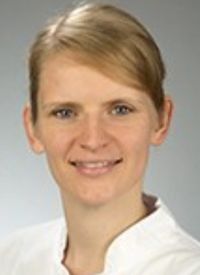Article
Salvage Daratumumab Reaches High ORR in Relapsed Myeloma Following Allogeneic SCT
Author(s):
Patients with multiple myeloma who relapsed following allogeneic stem cell transplantation and also failed several posttransplant therapies demonstrated a strong response to daratumumab salvage therapy.
Sonja Essmann MD

Sonja Essmann MD
Patients with multiple myeloma who relapsed following allogeneic stem cell transplantation (SCT) and also failed several posttransplant therapies demonstrated a strong response to daratumumab (Darzalex) salvage therapy, according to findings presented at the 2019 European Society for Blood and Marrow Transplantation Annual Meeting.
At a median follow-up of 14 months, the 1-year overall survival (OS) rate was 90.9% after the first daratumumab administration.
“Daratumumab shows an encouraging efficacy and acceptable toxicity profile in patients with relapsed/refractory myeloma after allogeneic SCT,” the study authors wrote in the poster. Although allogeneic SCT has curative potential in patients with multiple myeloma, there is a high relapse rate, with second-line treatment remaining an unmet medical need.
“Data addressing the choice of an optimal salvage therapy regimen for these heavily pretreated patients are missing,” according to the authors. The study was led by Sonja Essmann MD, of the Department of Stem Cell Transplantation at the University Hamburg-Eppendorf, in Hamburg, Germany.
Daratumumab targets CD38, which is overexpressed on the surface of plasma cells in multiple myeloma. The agent is approved as a single agent for patients with multiple myeloma who have received ≥3 prior lines of therapy, including a proteasome inhibitor and an immunomodulatory (IMiD) agent, or who are double refractory to a proteasome inhibitor and an IMiD agent; in combination with lenalidomide (Revlimid) and dexamethasone, or bortezomib (Velcade) and dexamethasone, for the treatment of patients with multiple myeloma who have received ≥1 prior therapy; in combination with pomalidomide (Pomalyst) and dexamethasone for the treatment of patients with multiple myeloma who have received ≥2 prior therapies, including lenalidomide and a proteasome inhibitor; and in combination with bortezomib, melphalan, and prednisone for the treatment of patients with newly diagnosed myeloma who are ineligible for autologous stem cell transplant.
In the trial, investigators evaluated daratumumab as salvage therapy in 22 patients relapsing after allogeneic SCT who also did not respond to a variety of post allogeneic SCT treatments; patients had undergone allogeneic SCT at the University of Hamburg Hospital.
Prior to allogeneic SCT, 21 patients had received an autograft, 9 patients had ≥2 autografts, and 4 patients had an allograft. Upon relapse and prior to receiving treatment with daratumumab, patients had received a median of 2 (range, 0-4) salvage lines of therapy that included cyclophosphamide, etoposide, bortezomib, lenalidomide, pomalidomide (Pomalyst), and carfilzomib (Kyprolis). The median age was 64 years (range, 40-72) and 10 patients were male.
All patients were treated with single-agent daratumumab as salvage therapy, which was initiated at a median of 19 months (range, 0-43) after relapse or disease progression. Three patients had stable disease upon initiation of daratumumab and the remaining 19 patients had progressive disease. At a median of 11 daratumumab infusions, combination therapy was initiated in 14 patients upon observation of a slow rise of paraprotein and/or free light chains or no response to monotherapy. Eleven patients received combination treatment with daratumumab and an immunomodulatory agent; of these, 10 received lenalidomide and 1 patient received pomalidomide. Three patients received daratumumab plus bortezomib.
At a median of 7 days (range, 4-372) after the first daratumumab administration, responses including a decrease of ≥50% of paraprotein and/or free light chains, were observed. The response rate was 68% and comprised 2 complete responses, 8 very good partial responses and 5 partial responses. Responses lasted for a median 5.0 months (range, 0.5-26.6). Of the 15 responding patients, 5 had received salvage treatment with daratumumab as monotherapy, 8 had received daratumumab/lenalidomide, and 1 patient each had received daratumumab combined with bortezomib or pomalidomide.
The safety analysis revealed that 20 adverse events (AEs) occurred in 13 (59%) patients during the first daratumumab infusion, which included dyspnea (n = 5), musculoskeletal pain (n = 4), shivering (n = 3), cough (n = 2), bronchospasm (n = 2), and acute coronary syndrome, skin rush, facial edema, and eye pressure (n = 1 each). Nineteen of these AEs were mild or moderate (CTC 1-2).
Overall, a median of 14 (range, 3-38) daratumumab infusions were delivered. No treatment discontinuations occurred due to AEs. Daratumumab treatment was temporarily interrupted in 3 patients due to late onset infections, which included pneumonia in 2 patients and urinary tract infection in 1 patient. One patient died due to disease progression and 1 patients died due to severe infection/sepsis.
Further research is needed to investigate the role of daratumumab in combination with immunomodulatory agents or proteasome inhibitors in the second-line setting, the authors concluded in their poster.
Essmann S, von Pein U-M, Klyuchnikov E, et al. Daratumumab as salvage therapy in relapsed/refractory multiple myeloma patients after allogenic stem cell transplantation. Presented at: 2019 European Society for Blood and Marrow Transplantation Annual Meeting; March 24 to 27, 2019; Frankfurt, Germany. Abstract B249.






%20(2)%201-Recovered-Recovered-Recovered-Recovered-Recovered.jpg?fit=crop&auto=format)

%20(2)%201-Recovered-Recovered-Recovered-Recovered-Recovered.jpg?fit=crop&auto=format)
%20(2)%201-Recovered-Recovered-Recovered-Recovered-Recovered.jpg?fit=crop&auto=format)